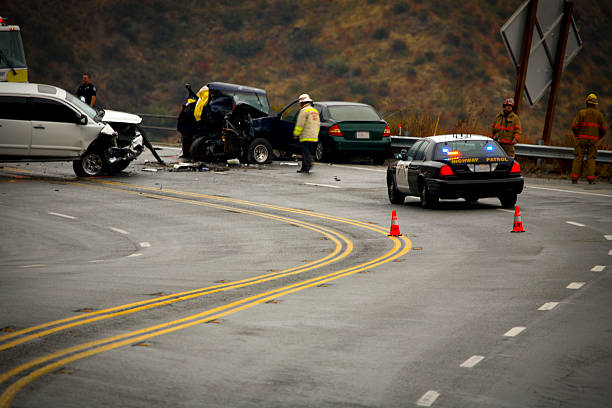Vehicular manslaughter, vehicular homicide, involuntary manslaughter, or dangerous driving causing death, is a severe criminal offence in New South Wales (NSW), Australia. It occurs when a person causes the death of another person due to reckless driving.
Ordinary negligence is typically seen as inattention or a careless mistake where the lack of reasonable care resulted in the death of someone else (unintentional vehicular manslaughter).
This article will dive into the concept and legal consequences of vehicular manslaughter.
Definition of Gross Vehicular Manslaughter
Driving is an everyday activity in our lives. However, it can become dangerous when drivers fail to adhere to traffic rules and regulations. Dangerous driving causing death is a serious offence that can result in severe consequences. In New South Wales (NSW), Section 52A of the Crimes Act 1900 defines this offence.
Section 52A defines vehicular manslaughter or dangerous driving causing death as “A person is guilty of the offence of dangerous driving occasioning death if the motor vehicle driven by the person is involved in an impact occasioning the death of another person and the driver was, at the time of the impact, driving the vehicle: –
- under the influence of intoxicating liquor or of a drug, or
- at a speed dangerous to another person or persons, or
- in a manner dangerous to another person or persons.”
Legal Consequence of Vehicular Manslaughter
The legal consequences of vehicular manslaughter in NSW include imprisonment, fines and the suspension or cancellation of the driver’s licence. The severity of the punishment can depend on the driver’s culpability level, the incident’s circumstances, and the harm caused to the victim and their family. The circumstances of committing this offence and the associated sentence are described in Section 52A of the Act.
Imprisonment
The punishment for dangerous driving causing death in Australia is imprisonment. The length of the maximum sentence depends on the circumstances surrounding the offence.
Dangerous Driving Causing Death: Imprisonment for 10 Years
Dangerous driving causing death occurs if the vehicle driven by the person is involved in an impact occasioning the death of another person and the driver was, at the time of the impact, driving the vehicle
- (a) under the influence of intoxicating liquor or of a drug, or
- (b) at a speed dangerous to another person or persons, or
- (c) in a manner dangerous to another person or persons.
Aggravated Dangerous Driving: Imprisonment for 14 Years
An aggravated offence of dangerous driving takes place if the person commits the offence of dangerous driving occasioning death in circumstances of aggravation. A circumstance of aggravation means:
- The prescribed concentration of alcohol was present in the accused’s breath or blood, or
- The accused was operating the involved vehicle on a road at a speed that exceeded the posted speed limit (if any) for that section of road by more than 45 kilometres per hour, or
- The accused was driving the vehicle to avoid being pursued by a police officer, or
- While under the influence of a drug (other than alcohol) or a combination of drugs, the accused’s ability to drive was significantly affected (whether or not intoxicating liquor was part of that combination).

Dangerous Driving Occasioning Grievous Bodily Harm: Imprisonment For 7 Years
Dangerous driving occasioning grievous bodily harm occurs if the vehicle driven by the person is involved in an impact occasioning grievous bodily harm to another person and the driver was, at the time of the impact, driving the vehicle:
- (a) under the influence of intoxicating liquor or of a drug, or
- (b) at a speed dangerous to another person or persons, or
- (c) in an unlawful and dangerous act to another person or persons.
Aggravated Dangerous Driving Occasioning Grievous Bodily Harm: Imprisonment for 11 Years
If the person commits the offence of dangerous driving occasioning grievous bodily harm in circumstances of aggravation.
Automatic Disqualification from Driving
Automatic disqualification is a penalty under the Road Transport Act 2013 (NSW) that immediately suspends a driver’s licence. It is called “automatic” because the driving offences the driver commits trigger the penalty without needing a court appearance or conviction.
If you are facing conviction of dangerous driving causing death, the disqualification of your licence will be automatic. The length of the disqualification depends on the severity of the offence and your driving history. The disqualification period is typically between 2 to 5 years for a first-time offender. However, if you have a prior conviction for a similar offence, the disqualification period can be as long as 10 years or even a lifetime disqualification.
It is important to note that the automatic disqualification for dangerous driving causing death is mandatory. This means that the court cannot reduce or waive the disqualification period. It is imposed automatically upon conviction, and the offender must serve the entire disqualification period before applying for the reinstatement of their licence.
Defences against Vehicular Manslaughter
Drivers charged with vehicular manslaughter may be able to mount a defence, such as arguing that they were not driving negligently. However, these defences are often challenging to prove, and drivers found guilty of driving causing death may face serious legal consequences.
Section 52A of the Crimes Act 1900 provides that it is a defence to the offence if the death or grievous bodily harm occasioned by the impact was not in any way attributable:
- To the fact that the accused was under the influence of alcohol, drugs, or a combination of drugs when they received the charge.
- To the speed at which the accused drives the vehicle, or
- To the manner in which the accused drives the vehicle.
Vehicular manslaughter or dangerous driving causing death is a serious criminal offence in Australia and carries severe legal consequences. These consequences include imprisonment and disqualification from driving. Drivers need to be aware of the potential legal implications of their driving actions and always drive safely and responsibly.

Seeking Legal Help from a Traffic Offence Lawyer
You must understand your legal rights and options if there is a vehicular manslaughter charge against you. A traffic offence can range from minor infringements, such as speeding or running a red light, to serious offences, like drunk driving, gross negligence, or dangerous driving causing serious injury or death. Regardless of the severity of the offence, it’s vital to seek legal advice and representation.
JB Solicitors has a team of skilful attorneys who can provide legal advice and guidance on vehicular manslaughter charges against you, potential outcomes, and options. We will explain the legal process and help you understand your rights and obligations. We can also represent you in court, negotiate plea bargains, help you understand the consequences, and provide emotional support.
Contact an experienced criminal defence attorney today.
